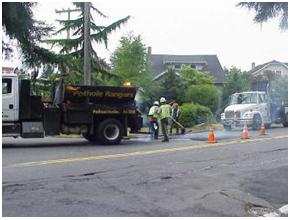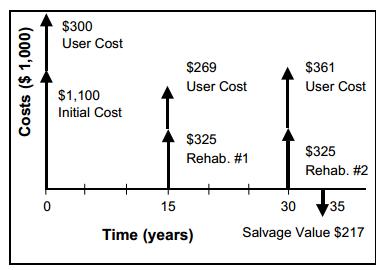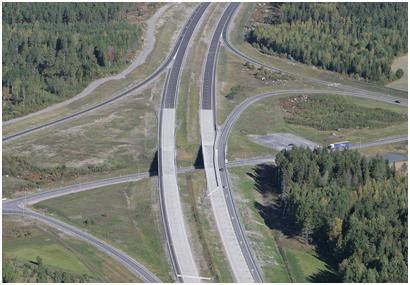The freedom to choose is a good thing right? Most owners or agencies have been building roads for many years and have a good idea of what roadways work for certain situations and how they like things built. In some situations however, contractors may have better solutions to save money, improve quality or both. Alternate bidding is a design strategy that allows contractors additional freedom to decide how they want to bid on a project and it is a strategy that is gaining popularity in many agencies.
What is Alternate Bidding?
Alternate bidding is when an agency allows project to be bid with several alternative material types to achieve a certain roadway structure design. On most projects, these alternatives would usually be PCC and HMA and they would either be designed to be equivalent in terms of design life or an additional lifecycle costs analysis (LCCA) adjustment factor would be added to the bid price. Many DOTs are using alternate bidding today to different extents and with varying policies on the use of LCCA adjustment factors.

Adjustment Factor
LCCA is an analysis technique that can be used to compare the economic impacts of various pavement designs over the life of roadway. The LCCA portion of alternate bidding can often be required to account for the differing life spans and maintenance required between pavement types. This component of a bid is usually a combination of user delay cost, rehabilitation cost, and annual maintenance cost. This LCCA adjustment factor is typically added to the base bid amount.
Alternate bidding usually results in contractors bidding on the pavement type they are most confident constructing. Some DOTs simply add a factor to asphalt pavements, with the assumption that they require more maintenance than concrete pavements, while others use adjustment factors in specific situations, such as when alternatives have life cycle costs that are not within 20% of each other. In general, alternate bidding is most appropriate when the life cycle costs are most similar, as this may avoid the adjustment factor and associated speculative costs.

Benefits of Alternate Bidding
Now surely if you’re going to go through all the trouble to allow multiple designs, there must be some good reason to do so. Typically the use of alternate bidding can result in an increase in number of bids per project. This increased competition can often drive down the construction costs. Some state DOTs have even noticed that alternate bid projects show lower price per ton of asphalt and price per cubic yard of concrete than similar projects without alternate bidding (Merritt, Ferregut & Rasmussen, 2009[2]).
Considerations with Alternate Bidding
Unfortunately there are tradeoffs to consider when looking at alternate bidding. By offering two bidding options, additional drawings and specifications will be required in a bid package which requires more money and effort from the owner to produce. This means that alternate bidding is probably not very cost effective on small projects that may not present much of a money saving opportunity from the outset.
Alternate bidding can also cause controversy over the design lives of the presented options. In cases where a product is new or data is unavailable to give an accurate estimate of the quality or longevity of a pavement, the LCCA adjustment factor may be questioned. It is important, whenever possible, to have appropriate performance data for the available alternatives, to describe the alternate bid calculation methods, and to make clear the design methods for each alternative. The LCCA adjustment factor needs to be thoroughly described, including how the design lives were determined and how yearly maintenance costs were calculated (likely from a Pavement Management System).
Also, though alternative bidding may decrease overall project costs, careful monitoring must be performed to ensure that the cost of this is a decrease in quality or longevity.

Performance Specifications
Alternate bid projects can also be accompanied with performance specifications. As you might imagine, these are specifications that describe how the roadway should perform over time. This applies mostly to design-build projects but is an ideal use of alternate bidding. These help to ensure a quality product is constructed but should not specify methods to meeting the specified results. These can help to encourage contractor innovation and can reduce the risk on the owner agency. Performance specifications can be useful with alternative bidding because they set an end goal but do not discriminate between pavement types or project approaches. This lets the contractor select the method and materials and allows them to construct the roadway in the most efficient and cost effective way.
In Use
Some agencies use alternate bidding whenever possible, some only in certain situations, and some are not yet ready to implement. The FHWA, for instance, discouraged its use initially but has warmed up to the idea and provided some guidelines for how to properly manage an alternative bid project (FHWA, 2008[3]). Alternative bidding may not be appropriate for all projects but in the right situation, such as when a project is using a design build delivery, has performance specifications, or is large enough to warrant multiple designs, it can save money and improve competition.
To learn more check out the following sources:
Merritt, D., Ferragut, T. & Rasmussen, R. 2009. Status and Options for Alternate Pavement Type Bidding. 1st International Conference on Transportation Construction Management. Available at: http://www.tcm-2.org/presentations/Tuesday/1015_ConstructionPerformanceSpecifications_Merritt.pdf
Turgeon, C. 2009. “Alternate Bid Pavement Type Selection or Whose Coin Should We Flip?” Available at: http://www.terraroadalliance.org/events/pavementconf/2009/documents/altbid-turgeon.pdf
Looney, P. 2010. “Pavement Type Selection and Alternate Pavement Bidding.” KYTC Partnering Conference. http://transportation.ky.gov/highway-design/conference%20presentation/pavement%20type%20selection%20and%20alternate%20pavement%20bidding.pdf
Federal Highway Administration (FHWA). 1998. Federal Highway Administration. “Life-Cycle Cost Analysis in Pavement Design – Interim Technical Bulletin.” Report No. FHWA-SA-98-079. Available at: http://isddc.dot.gov/OLPFiles/FHWA/013017.pdf
Federal Highway Administration (FHWA). 2008. “Clarification of FHWA Policy for Bidding Alternate Pavement Type on the National Highway System.” Available at: http://www.fhwa.dot.gov/pavement/081113.cfm%20
- Federal Highway Administration (FHWA). 1998. Federal Highway Administration. “Life-Cycle Cost Analysis in Pavement Design – Interim Technical Bulletin.” Report No. FHWA-SA-98-079. Available at: http://isddc.dot.gov/OLPFiles/FHWA/013017.pdf↵
- Merritt, D., Ferragut, T. & Rasmussen, R. 2009. Status and Options for Alternate Pavement Type Bidding. 1st International Conference on Transportation Construction Management. Available at: http://www.tcm-2.org/presentations/Tuesday/1015_ConstructionPerformanceSpecifications_Merritt.pdf↵
- Federal Highway Administration (FHWA). 2008. “Clarification of FHWA Policy for Bidding Alternate Pavement Type on the National Highway System.” Available at: http://www.fhwa.dot.gov/pavement/081113.cfm%20↵

